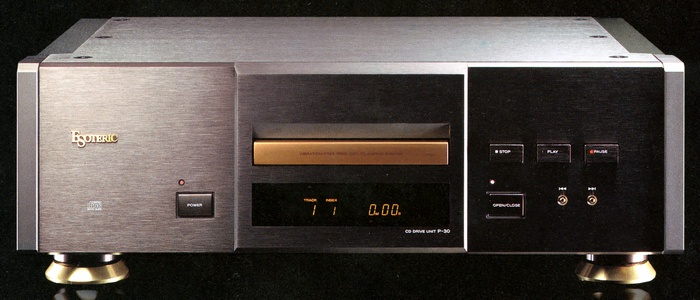
ESOTERIC P-30
¥ 350,000 (around 1995)
Commentary
A compact disc transport equipped with a DSRLL circuit.
The mechanism is equipped with TEAC's original Vibration-Free RigidDisc-Clamping System (VRDS).
By clamping the disk on a high-mass turntable with the same diameter as the disk, the VRDS completely eliminates the inherent vibration of the disk itself and unnecessary vibration of the mechanism system. By giving an extremely gentle tilt to the disk crimping surface, the warpage and distortion of the disk are corrected. The pickup, which is finely adjusted to the same angle as the tilt angle of the turntable, always realizes pit reading at the center of the optical axis of the pickup.
This VRDS mechanism greatly improves the relative optical axis accuracy of the disk pit surface, minimizing unnecessary servo current, greatly reducing disk read errors and preventing timing errors (jitter) in the clock circuit.
The P-30 uses high-precision die-cast aluminum for the turntable, which is supported by a bridge with thick reinforced rib structure. The mechanical base is made of a special polymer material with a low coefficient of thermal expansion and resistance to temperature changes. It has twice the specific gravity of ABS resin.
The drive motor is a high-grade brushless Hall motor that boasts high torque, providing excellent rotational stability and durability.
Furthermore, by floating the entire turntable mechanism with a copper-plated sub-chassis, vibration modes are reduced.
A DSRLL (Digital Servo Ratio Locked Loop) circuit is installed to reduce jittering.
In a DSRLL circuit, input signals are pooled in a RAM and processed in a low-speed closed loop that is fully synchronized with the ratio of the clock generated with quartz accuracy. This acts as an effective jitter filter for sound quality.
On the other hand, the ROM incorporated in the DSRLL circuit uses two sample sections of jitterless data obtained from the RAM.16It is used as a high-precision coefficient generation device to satisfy with (65,536) data. It calculates and processes at the clock timing of the quartz precision requested from the output by the arithmetic unit of the final stage.
The P-30 resamples CD-format 44.1kHz/16-bit PCM data to 48kHz/24-bit PCM data.
With this assumption of resampling processing, the DSRLL circuit is used to operate as an extremely effective jitter-filter, suppressing the mechanism jitters mixed into the digital output to -40dB (1/100) in the audible band above 300 Hz. The suppression characteristic below 300 Hz is a filter curve with a first order slope (-20dB/dec or -6dB/oct), which is effective from 3 Hz.
It outputs 48kHz/24-bit PCM resampled by the DSRLL circuit in a high-precision mode with a precision of ± 50 ppm (level I). To maximize the performance of externally connected D/A converters, XLR and RCA terminals are equipped with LAN isolation transformers.
Especially for the ST output, the sampling frequency of 48 kHz brings the original ST transmission frequency into the range of 1 MHz to 50 MHz, and the quality of the ST output is further improved than that at 44.1 kHz.
The digital outputs of the ST, XLR and RCA Route 3 can be switched by ICs without using a mechanism switch because each of them has a driver stage.
In order to prevent the mixing of mechanical jitters from the power supply and to improve the accuracy of the DSRLL, the power transformer for the mechanism system and the DSRLL system are completely separated. The power transformer is located outside the rear panel to prevent the influence of the flux on the mechanical control system.
The circuit board dedicated to the power supply section has been designed to have an optimum layout in terms of circuit and structure to further improve its quality.
The chassis has a double-layered structure consisting of copper-plated main and sub-chassis. Inside, the VRDS mechanism is supported by an independent sub-chassis, and the DSRLL system and servo system are separated into independent boxes.
Each stage is copper-plated for electrical shielding, and the chassis steel plate is constructed with diamond structure. In addition, the front and side panels are damped using aluminum extruding material with the thickest part of 10 mm to reduce natural vibration and resonance.
The legs use an original pinpoint foot with a hybrid structure combining brass blocks with stainless steel pins.
This pinpoint foot is supported by 3 points, 2 points at the front and 1 point at the rear for optimum mechanical grounding. In addition, machined aluminum material is used for the pinpoint base to give moderate loss. This clarifies the fulcrum and moving point of vibration and prevents ambiguous resonance.
In addition, the center of gravity is laid out at the center of a triangle connecting three pin points.
AT&T's ODL50II terminal is used for the ST terminal.
Other parts also use carefully selected high-quality audio parts.
Model Rating
| Type | CD Transport |
| Digital output | RCA : 0.5Vp-p/75 Ω XLR : 4.5Vp-p/110 Ω Optical ST : -16 ~ -12.5dBm/875nm |
| Dejittering ratio bell | -40dB |
| Jitter filter cutoff frequency | 3Hz |
| Jitter filter order | Primary |
| Pwer | 100 VAC, 50Hz/60Hz |
| Power consumption | 12W |
| External dimensions | Width 465x Height 157x Depth 390 mm (Including Legs) |
| Weight | 14.5kg |
.jpg)
.jpg)
.jpg)
.jpg)
.jpg)
.jpg)
.jpg)